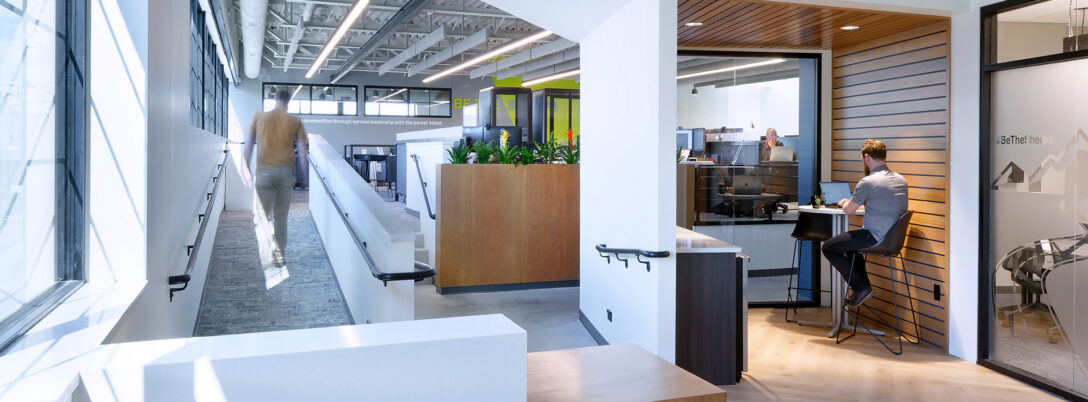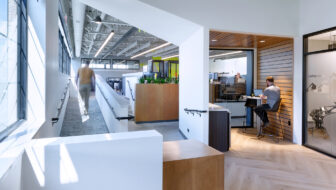Perhaps more now than ever before, individuals are keenly attuned to the importance of our own health and wellness needs, both physical and mental, and the impact, for better or worse, that our surroundings have on us. As individuals continue making their return to the office from working remotely, some are bringing along a level of discontent for the common workplace when compared to the home office that they’ve grown accustomed to working from. Employers that fail to address the dissatisfaction within the workplace may run the risk of a hit to the bottom line from the lost work time that occurs when employees become distracted and disengaged. However, office design or redesign — when done correctly — is an investment that can yield returns measured by increased performance and productivity, reduced turnover and absenteeism, and even the attraction and retention of top talent.1
Take note of your employees’ current disposition. Have you noticed disengaged or more distracted employees since the return from working remotely? The one variable we know has changed between work from home and return to office is the physical environment itself. In an article for Forbes, author Alan Kholl writes, “The research shows how [good] workplace design positively influences health, wellbeing, employee satisfaction, and performance. There is huge potential for improving and making a positive impact on employee wellbeing through human-centered design.” Good workplace design starts with air quality and adequate lighting and extends so far as to include those things that even remind us of home. “By simply offering employees areas to recharge and taking their comfort into consideration, you can easily make subtle changes to improve the physical environment at your office.”2
For all the time we spend in the workplace — about a third of our life overall — it is in everyone’s best interest to ensure we are at our best when we’re there. “Workplaces and work practices should enable and encourage people to do their best work,” writes author Kate Lister in an article for the Facility Management Journal entitled Show Me the Money: The Bottom Line on Workplace Change. She goes on to make a case for the gains an organization might see in employee productivity and performance as a result of making the right kinds of changes within the physical environment. “In terms of the workplace, that means removing the friction that keeps people from performing their best…If the person is cold, or in pain, or hungry, or frustrated by technology, they simply can’t do their best work. Unless these workplace elements are right, people simply can’t even think about the kinds of things that allow them to do their best work.”3
We’ve established that the physical elements of workplace design can have either a positive or adverse effect on employee productivity and performance — so what, then, does the ideal workplace look like? According to a wide body of research, the right physical environment should include the following:3
- Customizable thermal controls
- Visual and sound privacy options
- Good lighting
- Good air quality
- Effective ergonomics
- Efficient wayfinding
- Appropriate adjacencies
- Easy ways of finding team members
- Access to decision makers
- Appropriate noise levels and sound options
- Easy access to a variety of spaces and places
- The right technology
- Access to healthy food and beverages
- The right amenities
- Visual reinforcement of the organization’s mission and values
- Stress-reducing elements, such as biophilla, sounds of nature, outdoor areas
- Attention to aesthetics
Given those attributes, how does your office environment compare? Are your employees provided an environment that promotes collaboration but also welcomes and supports quiet concentration? According to Bill Conley, Fellow of the International Facility Management Association (IMFA), “open-plans” allow for a flexible office design that offers a variety of work environments, including quiet spaces. Employees can find suitable spots within an open plan office that allows them to choose where to work and when. “They can select spaces more consistent with their needs, undisturbed or with a team,” states Conley.4 Regardless of whether or not they did it successfully through the pandemic, business professionals far and wide can attest to the importance of staying connected as a team in spite of recent social distancing requirements and the transactional nature of videoconference calls. Albeit important, the team component of corporate culture still seems to play second fiddle to the cubicle-filled production-driven office layouts that many executives envision.
In a Harvard Business Review article entitled Designing the Hybrid Office: From Workplace to “Culture Space,” authors Fayard, Weeks and Khan discuss how the traditional office building will need to become a “culture space” that provides workers with a social anchor, facilitating connections, enabling learning, and fostering unscripted, innovative collaboration. The authors go on to discuss how human cognitive processing, and our ability to communicate, collaborate, and connect with one another is affected by our environments. The increased number of “human moments” and face-to-face encounters in optimal office environments can result in employees that are “often energized and more likely to empathize with each other, which supports organizational culture and collaboration.”5
The idea of intentionally creating space in the workplace for casual social encounters may seem paradoxical to most executives, but new approaches to office design strike a balance between openness and privacy and incorporate design elements that enable social interactions of many types. According to the Harvard Business Review, “Work happens as much in the lounge and the kitchen as in the rooms where project teams brainstorm with whiteboards and Post-it notes. Seeing or overhearing these work sessions, formal and informal, is critical to learning the subtleties of good design and managing client relationships.”5
The physical workplace has the ability to become an embodiment of the corporate culture and a place where we do our very best work. “Employers are finally beginning to understand that workplace design and work practices that are good for people are good for the bottom line.”3 Does your office space reinforce your organization’s mission, promote effective communication, and have a positive impact on your employees’ overall wellbeing? It may be time to address the concerns of your returning staff, accommodate for growth, and reorganize your workspaces to make your operations more efficient. Instead of incrementally adjusting the existing footprint, your company may need to take a holistic look at how much and where space is required and how it fosters desired outcomes for collaboration, productivity, culture, and the work experience,4 and you may benefit from the help of a professional to do so.
While you probably don’t have your local architecture firm on speed dial, consider utilizing them as a source for professional guidance when it comes to creating efficient workflows, space planning, and facility assessments. At Paragon Architecture, we work alongside our corporate, healthcare, municipal, and education clients from concept to completion and beyond. Our team of professional architects and interior designers are experienced in new construction, renovations and remodels, adaptive reuse and restoration, and sustainable design. Regardless of what type of project we are working on, one constant is our careful consideration for how the human element interacts and thrives within the built environment. However, there is no one-size fits all approach, and we believe your organization will benefit from having a trusted partner to guide you through the process.
When you are ready to talk about your next project, give us a call and we’ll take action together. Our architects and interior designers are passionate project managers, ready to advocate your vision from the first sketch to your final phone call—and beyond. Ready to learn more about how your investment in the workplace can positively impact your business? Contact our team.
References
1 Harris, Gina. 2021. “Attracting & Retaining Top Talent: Architecture As A Competitive Advantage For Recruitment”. Paragon Architecture Blog. https://www.paragonarchitecture.com/attracting-retaining-top-talent/.
2 Kohll, Alan. 2019. “How Your Office Space Impacts Employee Well-Being”. Forbes. https://www.forbes.com/sites/alankohll/2019/01/24/how-your-office-space-impacts-employee-wellbeing/?sh=75ea4d3664f3.
3 Lister, Kate. 2019. “Show Me The Money”. Facility Management Journal, January/February 2019: 38-42. http://fmj.ifma.org/publication/?0=%7B&1=%22&2=i&3=s&4=s&5=u&6=e&7=_&8=i&9=d&10=%22&11=%3A&12=5&13=5&14=8&15=4&16=7&17=3&18=%2C&19=%22&20=p&21=a&22=g&23=e&24=%22&25=%3A&26=8&27=2&m=30261&i=558473&p=38&ver=html5.
4 Conley, Bill. 2021. “Tomorrow’s Office: Recognizing The Workspace Evolution”. Facility Management Journal, May/June 2021: 38-40. http://fmj.ifma.org/publication/?m=30261&i=707376&p=38&ver=html5.
5 Fayard, Anne-Laure, John Weeks, and Mahwesh Khan. 2021. “Designing The Hybrid Office: From Workplace To “Culture Space””. Harvard Business Review, no. March-April 2021. https://hbr.org/2021/03/designing-the-hybrid-office.



